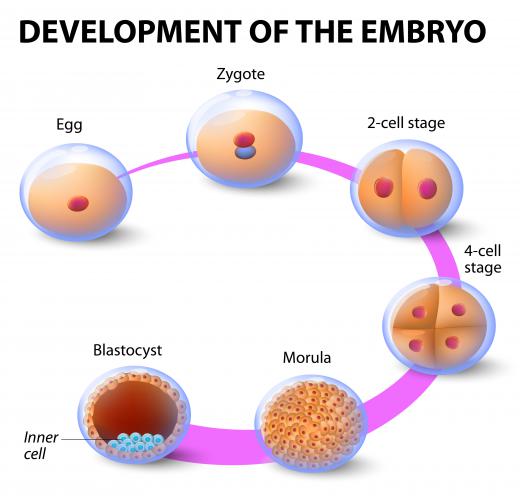What is a Germ Line?
 Mary McMahon
Mary McMahon
A germ line is a cell lineage which consists of cells which are used to pass down genetic inheritance to the next generation. Known as germ cells, these cells include gametocytes, which make eggs and sperm, as well as eggs and sperm themselves, and gametogonia, cells which give rise to gametocytes. The germ line is an uninterrupted chain of inheritance which can be traced back over many generations.
The germ line is present from the very start, when an egg and a sperm fuse. As the cell starts to divide and develop into an embryo, germ cells are specifically set aside; these cells will later generate eggs or sperm in the adult organism that the embryo will eventually become. The non-germ cells, known as somatic cells, will become various structures in the body. Somatic cells contain complete copies of the genome, but they differentiate to perform different functions, developing into neurons, muscle cells, bone cells, and so forth.

While somatic cells arise from the germ line, they are not part of it. Mutations to the somatic cells cannot be passed on to future generations, while changes to the germ line will be perpetuated. Some researchers have theorized that this could be valuable for gene-based therapies; in germ line gene therapy, changes could be made to the lineage of cells which contain genetic information that will be passed down.

A mutation in the line will not affect the body of the organism the mutation occurs in, but it will have an impact on the organism's offspring. For example, if a problem occurs during production of egg or sperm cells and that particular egg or sperm happens to become part of a zygote, this problem will impact the baby. A simple example of such a mutation is trisomy, in which someone inherits three chromosomes instead of two because two chromosomes failed to separate during the production of egg or sperm cells.
In addition to being of interest from a medical perspective, the germ line also provides a wealth of information about inheritance. Changes can be tracked through it to learn more about the history of an organism, and this lineage of cells can also be used to look at relationships between different groups of individuals. Humans, for example, share a common germ line even though it has diverged in a wide variety of directions as new human generations have been born.
AS FEATURED ON:
AS FEATURED ON:












Discussion Comments
Basically, for instance if you have any inherited disease in your egg or sperm, you are already affected by it and if you have kids these mutations will be passed on to your child. Also, if there is mutation happening in the sperm or egg, it will affect the next generation because you cannot be affected. The mutation in your egg or sperm will not make you. They will make another organism so that's why they will be affected. Sorry, it's a little bit confusing.
This idea of germ line and germ cells is news to me. I have never heard of it. Is it a fairly new idea? The only genetic words I've heard were chromosomes and mutation.
So, if there is a mutation within the cells that turn into the various structures of the body, any mutation won't be passed on to future generations. But if there is a mutation in the cells that will create sperm and eggs, mutations can be passed along to offspring.
It's interesting that if there is a mutation, it won't affect the human or animal that gets it. But, the offspring may be affected by the change.
Post your comments